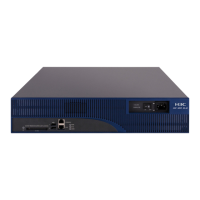3-11
z For a 10/100 Mbps port provided by the RPU, connect it to a PC or another router using a
crossover cable or to a Hub or LAN switch using a straight-through cable.
z For a 10/100/1000 Mbps port provided by the RPU, connect it to a PC or another router using a
crossover cable or to a Hub or LAN switch using a straight-through cable.
Step 2: View the LINK LED of the Ethernet interface: ON means a link is present and OFF means no link
is present. Check the line for the cause.
2) Connecting fiber-optic Ethernet interface cable.
In connecting optical fibers, observe the following:
z Do not over-bend the fiber. Its curvature radius must be greater than 10 cm (3.9 in.).
z Ensure that the Tx and Rx ends are correctly connected.
z Ensure that the fiber ends are clean.
Laser danger: Invisible laser radiation may be emitted from the fiber-optic ports which are connected
with lasers. To protect your eyes against radiation harm, never stare into an open fiber-optic port.
Follow these steps to connect a 10/100/1000 Mbps fiber-optic interface:
Step 1: Use two fibers to connect the Rx and Tx ends of the interface to another device: Rx to Tx, and Tx
to Rx.
Step 2: View the LINK LED of the 10/100/1000 Mbps Ethernet interface: ON means a link is present.
OFF means no Rx link is present; check the line for the cause.
Connecting AUX to a Modem
AUX port
AUX is an RS232 asynchronous serial interface, which can back up a WAN interface and provide dial
connection. In case of console failure, AUX can function as a console interface.
AUX cable
AUX cable is an eight-wire shielded cable. At one end of the cable is an RJ-45 connector for connecting
the console port on the router. At the other end are DB-9 (male) connector and DB-25 (male) connector.
You can plug either of them into the serial port on a modem as needed.

